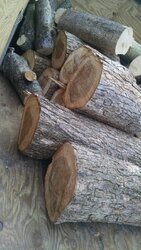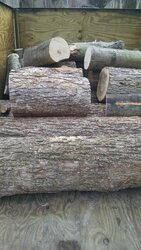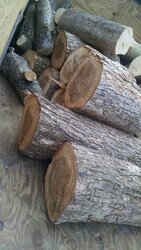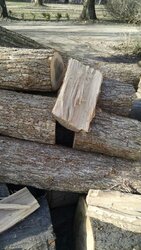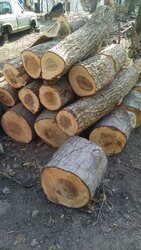wood ID. elm????
- Thread starter Jeff2009
- Start date
-
Active since 1995, Hearth.com is THE place on the internet for free information and advice about wood stoves, pellet stoves and other energy saving equipment.
We strive to provide opinions, articles, discussions and history related to Hearth Products and in a more general sense, energy issues.
We promote the EFFICIENT, RESPONSIBLE, CLEAN and SAFE use of all fuels, whether renewable or fossil.
You are using an out of date browser. It may not display this or other websites correctly.
You should upgrade or use an alternative browser.
You should upgrade or use an alternative browser.
- Status
- Not open for further replies.
Applesister
Minister of Fire
"Elms have alternating layers of a wafer type white cork sandwiched in the outer bark. Very distinctive and usually a chevron pattern in the grain pores between the spring wood and winter wood and wide growth rings. I see it on Red Elm and American.
This white wafer cork easily separates with a fingernail and feels soft to the touch.
The bark on Pignut hickory is harder than the wood on Elm. And pignut weighs almost twice as much as Elm.
Also fresh cut hickory has a very strong smell. This all cannot be deciphered from these pictures submitted.
Its up to the OP." - quote
This is my comment to to another ID. These two trees look exact. Bark is a little different.
This white wafer cork easily separates with a fingernail and feels soft to the touch.
The bark on Pignut hickory is harder than the wood on Elm. And pignut weighs almost twice as much as Elm.
Also fresh cut hickory has a very strong smell. This all cannot be deciphered from these pictures submitted.
Its up to the OP." - quote
This is my comment to to another ID. These two trees look exact. Bark is a little different.
Applesister
Minister of Fire
Doesnt look American and it doesn't look Red Elm. But there are other species. Photos can go just so far.
Is the wood super heavy?
Does it smell like elmers glue?
Is the bark soft? Or dense and hard?
Can you get a close up that's in focus?
Is the wood super heavy?
Does it smell like elmers glue?
Is the bark soft? Or dense and hard?
Can you get a close up that's in focus?
firefighterjake
Minister of Fire
I'm better at identifying a tree by leafs ... but to me the bark is wrong for American elm ... looks more like some type of maple to me.
Paulywalnut
Minister of Fire
I see two nice pieces of Ash in the back there. The front large ones look like Maple. It all looks good to me.
claydogg84
Minister of Fire
Applesister
Minister of Fire
claydogg84
Minister of Fire
That split is from the wood in question. Thank you. Any idea what variety.The split is most definitely Elm.
claydogg84
Minister of Fire
That split is from the wood in question. Thank you. Any idea what variety.
It looks like American Elm to me.
Thanks. That's what I was thinking also.It looks like American Elm to me.
nrford
Minister of Fire
DaveH
Member
firefighterjake
Minister of Fire
I changed my mind . . . took a good hard look at that last pic . . . and yeah . . . looks like elm. Not sure what I was thinking.
Time to up my meds I guess . . . or at least start taking some meds.
Drying time -- should burn in a year or so . . . burns better with two years. Wicked stringy . . . cannot imagine splitting it without the use of hydraulics.
Time to up my meds I guess . . . or at least start taking some meds.
Drying time -- should burn in a year or so . . . burns better with two years. Wicked stringy . . . cannot imagine splitting it without the use of hydraulics.
claydogg84
Minister of Fire
Anybody have experience will elm? How long are we looking at for a dry time?
I burned mainly American Elm my first year. It makes for decent firewood. Live Elm holds a tremendous amount of water, but will dry fairly quickly if you split it on the smaller side. I would say 1 drying season would get it in the low to mid 20s on your MM.
JA600L
Minister of Fire
My experience is with a dead elm. It created a lot of heat but it didn't offer much flame. Lots of strange blue flames and good coaling. I would mix it with some other variety but either way it is worthwhile. If the tree was alive you might want to wait 2-3 years to burn it.
I changed my mind . . . took a good hard look at that last pic . . . and yeah . . . looks like elm. Not sure what I was thinking.
Time to up my meds I guess . . . or at least start taking some meds.
Drying time -- should burn in a year or so . . . burns better with two years. Wicked stringy . . . cannot imagine splitting it without the use of hydraulics.
I have split a lot of elm and stringy is right. If it has a crotch or a piece with a limb I noodle those suckers. No sense in frustrating my self with the splitter.
Hehehe - elm. Hopefully you got one of the "easier" trees, cuz when they are tough...well, they are tough.
These aren't too bad. They were from a heavy wood area so they're straight and tall. Still tough but not impossible by hand.Hehehe - elm. Hopefully you got one of the "easier" trees, cuz when they are tough...well, they are tough.
- Status
- Not open for further replies.
Similar threads
- Replies
- 33
- Views
- 2K


